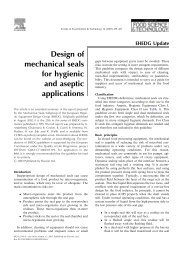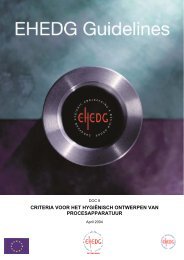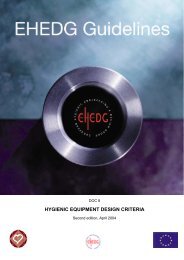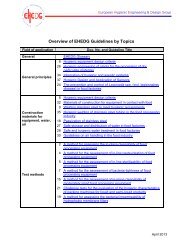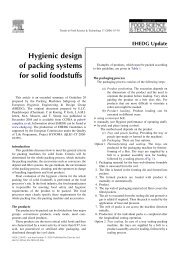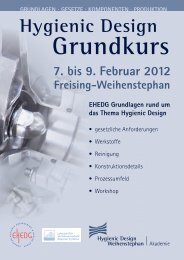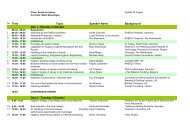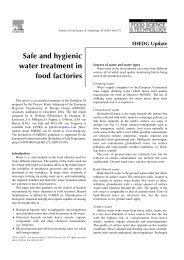Yearbook 2013/2014 - ehedg
Yearbook 2013/2014 - ehedg
Yearbook 2013/2014 - ehedg
You also want an ePaper? Increase the reach of your titles
YUMPU automatically turns print PDFs into web optimized ePapers that Google loves.
166 EHEDG Subgroups<br />
manufacturers within the same technology field. A number<br />
of mechanisms have allowed successful conclusion to the<br />
work groups’ tasks, including:<br />
• The breadth of the groups experiences - the flooring<br />
team consisted of manufacturers, academics, and a<br />
national agency, the drainage team had more than one<br />
representative from each company.<br />
• Where competition is direct, then work toward common<br />
agreement before wider group presentation.<br />
• The interrelationships between building components –<br />
for example floors and drains.<br />
• Intermediate stage presentation of intended structure<br />
of the proposal at the central Building Design Group<br />
meetings.<br />
Taking part in the extra meeting the flooring group had<br />
representation from ANSES - Brigitte Carpentier; Argelith<br />
– Volker Aufderhaar; BASF Ucrete – Phillip Ansell; with<br />
further input from Prof Vladimir Kakurinov. Key themes<br />
of the flooring group included a hygienic floors checklist;<br />
challenges in flooring; gradients; joints, materials; installation<br />
and waterproofing.<br />
The Drainage group from ACO – Martin Fairley, Vaclav<br />
Kralicek and Jiri Lonicek; and Blucher Metal A/S – Martin<br />
Frølund and Palle Madsbjerg. Key themes from the drainage<br />
group included flow and capacity, layout, application areas<br />
and examples, materials, installation considerations and<br />
floor interface details, maintenance and cleaning. Input from<br />
the door industry was supplied solely by manufacturer coolit<br />
– Kristian Kissing. Many others have made contribution to<br />
these teams as they progressed.<br />
As might be expected such an extensive overall work<br />
programme from the Building Design Group has potential<br />
to raise issues worthy of debate; one such issue related to<br />
the definition of segregation and zoning – critical elements<br />
of overall hygienic design principles in modern production<br />
facilities. A separate work group comprising of 5 participants<br />
(Kraft Foods, Unilever, Cargill, Heinz and Campden BRI), is<br />
to further the discussion on this central topic. Zone definitions<br />
could include:<br />
• Factory site – between the perimeter fence and the<br />
building envelope<br />
• Non food production area, e.g. locker rooms, canteens/<br />
restaurants, smoking areas, boiler rooms, workshops,<br />
machinery rooms, laboratories, offices, meeting rooms,<br />
living accommodation<br />
• Enclosed product areas, e.g. warehouses, despatch<br />
areas, cleaning stores<br />
• Raw material processing zone, e.g. slaughter house,<br />
vegetable washing, waste disposal<br />
• General processing zone, e.g. ingredients suitable for<br />
further processing, exposed packaging and processed<br />
products often termed Low risk, Low care or GMP<br />
areas<br />
• Controlled zones for decontaminated products,<br />
microbiologically driven and often termed High Care<br />
or High Risk areas for chilled RTE products or the<br />
Primary Salmonella Control Area for dry RTE products<br />
• Controlled equipment, e.g. clean to aseptic handling<br />
and filling<br />
It is anticipated that the Group will have its draft proposals<br />
in place by the end of 2012 or the beginning of <strong>2013</strong>. If it is<br />
met then a substantial piece of work has been produced in a<br />
relatively short timescale of just a little over a year – a great<br />
achievement.<br />
Chairman:<br />
Dr. John Holah<br />
Campden BRI<br />
Food Hygiene Department<br />
Chipping Campden<br />
GLOUCHESTERSHIRE GL55 6LD<br />
GREAT BRITAIN<br />
e-mail: j.holah@campden.co.uk<br />
phone: (+44 1386) 84 20 41<br />
EHEDG Subgroup<br />
“Chemical Treatment of Stainless Steel”<br />
Dr. Gerhard Hauser, e-mail: gerhardwrhauser@yahoo.de<br />
The task of the group was to review EHEDG Doc.18<br />
“Passivation of Stainless Steel” published in 1998 which<br />
gives essential recommendations to one of the most<br />
important properties of stainless steels for product contact<br />
surfaces in the food and beverage industry.<br />
Food equipment manufacturers and users choose stainless<br />
steels as the predominant material of construction because<br />
of their excellent mechanical properties combined with a<br />
high level of corrosion resistance and cleanability. The latter<br />
two attributes are the primary determinants of the material’s<br />
hygienic behaviour. They rely upon the ‘passive surface<br />
layer’, a chromium-rich oxide film which naturally forms on<br />
all stainless steels. This layer is adequately protective for the<br />
vast majority of food and beverage applications.



